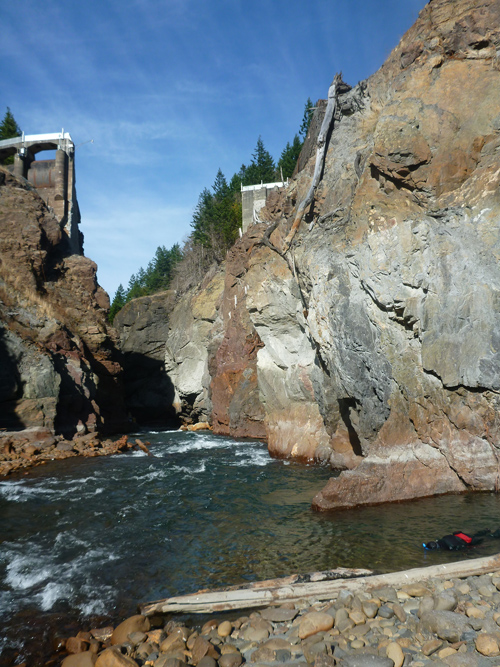
NPS photo
National Park Service News Release
Following an observation by a fisheries biologist and member of the Lower Elwha Klallam Tribe of a possible Chinook salmon in the former Lake Mills, two Olympic National Park fisheries staff conducted a snorkel survey of the Elwha River above the old Glines Canyon dam site.
They found three adult Chinook salmon, all between 30 and 36 inches long, in the former Lake Mills, between Windy Arm and Glines Canyon. Two fish were seen resting near submerged stumps of ancient trees;the third was found in a deep pool in the former Lake Mills.
“When dam removal began three years ago, Chinook salmon were blocked far downstream by the Elwha Dam,” said Olympic National Park Superintendent Sarah Creachbaum. “Today, we celebrate the return of Chinook to the upper Elwha River for the first time in over a century.”
“Thanks to the persistence and hard work of many National Park Service employees, the Lower Elwha Klallam Tribe and many other partners, salmon can once again reach the pristine Elwha watershed within Olympic National Park,” said Creachbaum.
In addition to the three Chinook, biologists counted 27 bull trout, nearly 400 rainbow trout and two small sculpin during their survey above Glines Canyon.
The biologists began their snorkel survey in Rica Canyon three miles above the old Glines Canyon dam site. They then snorkeled downstream through the Canyon, through the former Lake Mills and downstream to a point just above Glines Canyon.
Last week, park biologists confirmed that two radiotagged bull trout had migrated through Glines Canyon and were in Rica Canyon. The three Chinook observed this week were not radiotagged, but were seen by observers on the riverbank and in the water.
The following day, biologists counted 432 live Chinook in a 1.75 mile section of river just downstream of Glines Canyon, but still above the old Elwha dam site.
Elwha River Restoration is a National Park Service project that includes the largest dam removal in history, restoration of the Elwha River watershed, its native anadromous fisheries and the natural downstream transport of sediment and woody debris. For more information about this multi-faceted project, people can visit the Olympic National Park website at http://www.nps.gov/olym/
